A) price equals marginal cost.
B) marginal revenue equals marginal cost.
C) average total cost is minimized.
D) All of the above are correct.
F) A) and B)
Correct Answer

verified
Correct Answer
verified
Multiple Choice
In which of the following market structures does free entry and exit play an important role in the long-run equilibrium outcome? (i) perfect competition (ii) monopolistic competition (iii) monopoly
A) (i) only
B) (i) and (ii) only
C) (ii) and (iii) only
D) (i) , (ii) , and (iii)
F) B) and D)
Correct Answer

verified
Correct Answer
verified
Multiple Choice
In which of the following market structures can a firm earn an economic profit in the short run?
A) Perfect competition
B) Monopolistic competition
C) Monopoly
D) All of these market structures can earn an economic profit in the short run
F) All of the above
Correct Answer

verified
Correct Answer
verified
Multiple Choice
For the economy as a whole, spending on advertising comprises about what percent of total firm revenue?
A) 0.5
B) 2
C) 10
D) 20
F) B) and C)
Correct Answer

verified
Correct Answer
verified
Multiple Choice
Because monopolistically competitive firms produce differentiated products, each firm
A) faces a demand curve that is horizontal.
B) faces a demand curve that is vertical.
C) has no control over product price.
D) has some control over product price.
F) A) and B)
Correct Answer

verified
Correct Answer
verified
Multiple Choice
Joe's Juice Shop operates in a monopolistically competitive market. Joe's is currently producing where its average total cost is minimized. In the long run we would expect Joe's output to
A) decrease and average total cost to increase.
B) decrease and average total cost to decrease.
C) remain unchanged as Joe's is doing the best it can.
D) increase and average total costs to decrease.
F) A) and C)
Correct Answer

verified
Correct Answer
verified
True/False
A monopolistically competitive market is characterized by barriers to entry.
B) False
Correct Answer

verified
Correct Answer
verified
Multiple Choice
In the long run,
A) monopolistically competitive firms earn a higher profit than perfectly competitive firms because monopolistically competitive firms have some monopoly power.
B) monopolistically competitive firms produce a higher output than perfectly competitive firms because competition drives the perfectly competitive firms' output down.
C) both monopolistically competitive and perfectly competitive firms produce where P = MC.
D) both monopolistically competitive and perfectly competitive firms produce where P = ATC.
F) A) and D)
Correct Answer

verified
Correct Answer
verified
Short Answer
Figure 16-12 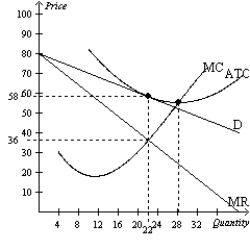 -Refer to Figure 16-12. When this firm profit-maximizes, what is the amount of the firm's profit or loss?
-Refer to Figure 16-12. When this firm profit-maximizes, what is the amount of the firm's profit or loss?
Correct Answer

verified
Correct Answer
verified
Multiple Choice
If a firm in a monopolistically competitive market successfully uses advertising to decrease the elasticity of demand for its product, the firm will
A) be able to increase its markup over marginal cost.
B) eventually have to reduce price to remain competitive.
C) increase the welfare of society.
D) reduce its average total cost.
F) C) and D)
Correct Answer

verified
Correct Answer
verified
Multiple Choice
As firms exit a monopolistically competitive market, profits of remaining firms
A) decline, and product diversity in the market decreases.
B) decline, and product diversity in the market increases.
C) rise, and product diversity in the market decreases.
D) rise, and product diversity in the market increases.
F) C) and D)
Correct Answer

verified
Correct Answer
verified
Multiple Choice
A new Mexican restaurant opened in the town of Manchester. The residents of the town are
A) happy because of the product-variety externality, while other restaurant owners are unhappy because of the business-stealing externality.
B) happy because of the business-stealing externality, while other restaurant owners are unhappy because of the product-variety externality.
C) unhappy because of the product-variety externality, while other restaurant owners are happy because of the business-stealing externality.
D) unhappy because of the business-stealing externality, while other restaurant owners are happy because of the product-variety externality.
F) B) and C)
Correct Answer

verified
Correct Answer
verified
True/False
The product-variety externality and the business-stealing externality are both spillover benefits of new firms entering a monopolistically competitive market.
B) False
Correct Answer

verified
Correct Answer
verified
Multiple Choice
Figure 16-10
The figure is drawn for a monopolistically-competitive firm. 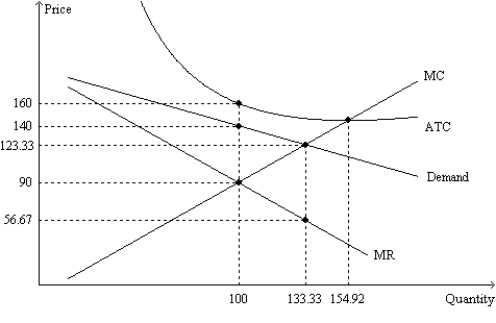 -Refer to Figure 16-10. The firm's maximum profit is
-Refer to Figure 16-10. The firm's maximum profit is
A) $-7,000.
B) $-5,000.
C) $-2,000.
D) The firm's maximum profit cannot be determined from the figure.
F) A) and B)
Correct Answer

verified
Correct Answer
verified
Short Answer
Figure 16-11 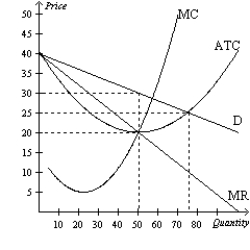 -Refer to Figure 16-11. If this firm profit-maximizes, how much cost will it incur?
-Refer to Figure 16-11. If this firm profit-maximizes, how much cost will it incur?
Correct Answer

verified
Correct Answer
verified
Short Answer
Table 16-7
A monopolistically competitive firm faces the following demand schedule for its product. In addition, the firm has total fixed costs equal to 20. 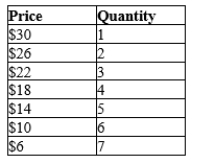 -Refer to Table 16-7. If this firm has a constant marginal cost of $7, what is the profit-maximizing level of output?
-Refer to Table 16-7. If this firm has a constant marginal cost of $7, what is the profit-maximizing level of output?
Correct Answer

verified
Correct Answer
verified
Multiple Choice
Figure 16-14 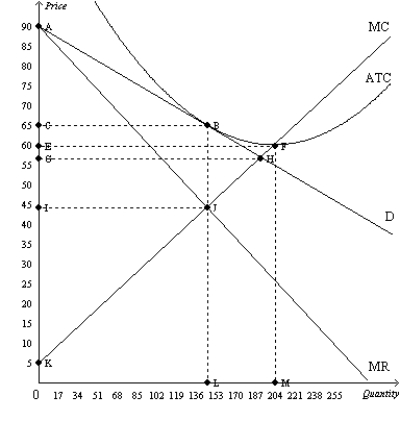 -Refer to Figure 16-14. The deadweight loss from production for this firm is represented by which of the following areas?
-Refer to Figure 16-14. The deadweight loss from production for this firm is represented by which of the following areas?
A) ABC
B) IJK
C) BHJ
D) BCIJ
F) A) and B)
Correct Answer

verified
Correct Answer
verified
Multiple Choice
Figure 16-5 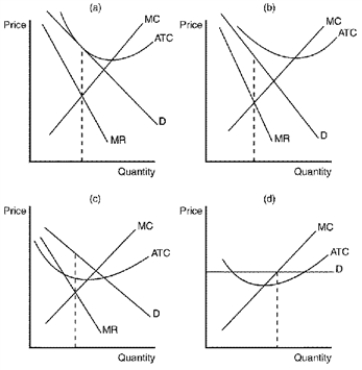 -Refer to Figure 16-5. Panel b is consistent with a firm in a monopolistically competitive market that is
-Refer to Figure 16-5. Panel b is consistent with a firm in a monopolistically competitive market that is
A) not in long-run equilibrium.
B) in long-run equilibrium.
C) producing its efficient scale of output.
D) earning a positive economic profit.
F) All of the above
Correct Answer

verified
Correct Answer
verified
Multiple Choice
Figure 16-14  -Refer to Figure 16-14. Which of the following represents the excess capacity of this firm?
-Refer to Figure 16-14. Which of the following represents the excess capacity of this firm?
A) BJ
B) GH
C) LM
D) There is no excess capacity.
F) B) and D)
Correct Answer

verified
Correct Answer
verified
Multiple Choice
A similarity between monopoly and monopolistic competition is that in both market structures
A) strategic interactions among sellers are important.
B) there are a small number of sellers.
C) sellers are price makers rather than price takers.
D) there are only a few buyers but many sellers.
F) All of the above
Correct Answer

verified
Correct Answer
verified
Showing 481 - 500 of 649
Related Exams